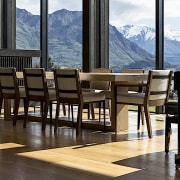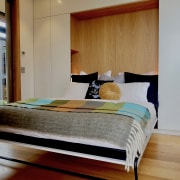Cool outlooks, snug interiors
Mountain homes naturally shore up against the same alpine weather that makes their outlooks so beautiful. This home takes it all a step further – eliminating thermal bridging is just one of its war-on-cold strategies
Designed by Eliska Lewis Architects
From the architects:
The homeowners’ brief was for a timeless look with emphasis on timber and natural stone – one owner, a geologist, has a keen eye on the characteristics of these materials. Plus it was imperative that we kept with these key elements to complement the surrounding mountain vistas and environment.
The owners needed the design to maximise the number of rooms with a lake view, to provide flow through the house suitable for a young family, and also to provide shelter for changing weather.
They wanted a house with personality, and a built interior where everything has a place. Another ask was for uncompromising thermal performance of the building envelope.
With the budget in mind, we reduced the footprint and kept the overall form simple, to allow more funds for thermal performance and seamless detailing and finishing. Flexible spaces became multi-purpose rooms with a hidden murphy bed, desks, lounging area, that at any time could be transformed into private guest rooms.
The street elevation is restrained, with high glazing for morning sun and an elevated view through the building, while giving privacy to the occupants.
Height restrictions on the property guided the roof design, as a low-lying profile achieved a floor level that allowed views over the Kanuka trees. Invited in through the solid façade, you enter into light filled spaces arranged around an interior courtyard, and a covered outdoor room that links to the separate retreat wing.
Rooms look through other rooms to capture views beyond. Corner openings and pocket sliding doors extend internal spaces to become part of the built outdoor surroundings.
Extensive joinery drawings were provided, planning every aspect of how occupants will travel through the spaces. Timber fixed louvres set in front of opaque glazing define the main entrance while concealing the storage areas within.
Steel portals between windows were insulated and detailed with crafted timber to give depth and character – to frame the views while giving a sense of enclosure.
Architecture is an opportunity to promote environmental design. The strategies involved in this project included designing construction methods for sandwich layered floors, ceilings and walls, to address thermal bridging, airtightness, and vapour control, providing comfortable living temperatures, while protecting the internal structure from condensation risks associated with an alpine environment.
We maintained insulation levels by not penetrating airtightness layers in walls or ceilings. Services were methodically planned and contained in bulkheads that became design features incorporated into joinery design.
The oak floors are on battens with PIR insulation above the structural slab, eliminating thermal bridging. Grey powder-coated radiators were made a feature, either contrasting on white walls, or blending into the concrete fireplace, or disappearing from view into the oak floor with matching oak grille.
Passive ventilation through interior courtyards away from prevailing west-winds allow fresh air movement in warm months, and during the winter when internal air moisture is high and windows less often open, good indoor air quality is achieved with a heat recovery ventilation system. The result is a building that has long-lasting comfort for future generations.
Read about the kitchen in this home
Credit list
Architect and interior designer
Kitchen designer
Roof
Cladding
Wallcoverings
Heating
Awards
Story by: Trendsideas
Photography by: Simon Devitt
Home kitchen bathroom commercial design















